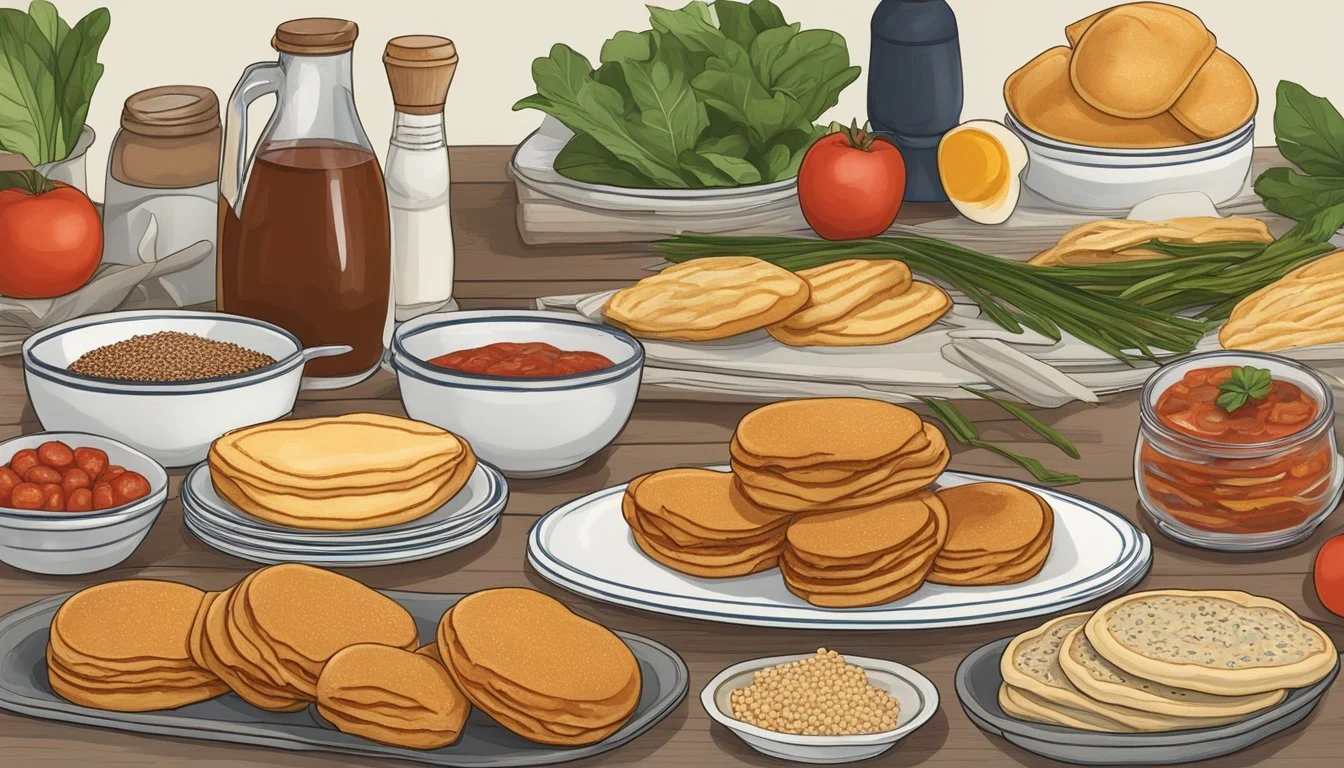What Food is West Virginia Known for?
Unveiling Appalachian Delicacies
West Virginia, nestled in the heart of Appalachia, holds a rich culinary tradition that reflects its history and cultural heritage. The state's distinctive fare is a testament to the ingenuity and resourcefulness of its people. Characterized by hearty flavors and comforting textures, West Virginia's foods often feature ingredients sourced directly from its lush landscapes and local farms.
Among the state's numerous contributions to the American culinary scene, the pepperoni roll stands out as a quintessential West Virginian creation. Originating from the coal mining communities as a convenient and filling meal for miners, this simple yet delicious food item has become a staple across the state. Additionally, biscuits and gravy, a country classic, are synonymous with West Virginia breakfast traditions, showcased by establishments like Tudor's Biscuit World, which have turned this homely dish into a regional icon.
The cuisine of West Virginia also celebrates wild edibles such as ramps, known for their pungent aroma and flavor reminiscent of onions and garlic. These wild leeks are foraged in the springtime and are often celebrated at local food festivals that honor the unique culinary practices of the region. From the rugged hills to the bustling food festivals, the flavors of West Virginia tell the story of a state firmly rooted in tradition yet constantly evolving its palate.
Historical Context and Cultural Significance
West Virginia's food scene is a rich tapestry interwoven with the heritage of Italian immigrants, the foraging traditions of Appalachia, and a history built around coal mining. These elements have collectively shaped a culinary identity that is both unique and indicative of the state's cultural past.
Influence of Italian Immigrants
Italian immigrants have significantly molded West Virginia's culinary landscape. The pepperoni roll, a state specialty, emerged out of the necessity for coal miners to have a filling and easily transportable lunch (What wine goes well with lunch?). Originating in Clarksburg, the simple, yet satisfying combination of spicy pepperoni encased in soft bread dough, reflects the influence of these immigrants. The state celebrates this heritage annually at the West Virginia Italian Heritage Festival.
Appalachian Traditions and Native Ingredients
Appalachian cuisine in West Virginia has always emphasized making the most of the available resources. Ingredients like ramps (a type of wild onion), morels (a wild mushroom), venison (What wine goes well with venison?), and apples are staples resulting from the foraging traditions passed down through generations. Pioneered by Native Americans and later adopted by settlers, these foods have become a part of West Virginia’s culinary traditions.
Coal Mining Heritage
The coal mining industry has not only shaped the landscape of West Virginia but also its food traditions. Coal miners required meals that were both energy-dense and non-perishable. Foods like the West Virginia hot dog, loaded with chili, mustard (how long does mustard last?), and onions, and slathered with grease from a quick grill, are embodiments of the simple yet hearty fare that defined a coal miner's lunch. The reliance on easily preserved foods has left a mark on the local culinary practices that persists to this day.
Iconic West Virginia Foods
West Virginia is celebrated for its rich culinary heritage, which features a blend of Appalachian traditions and a unique take on American classics. From the essential pepperoni roll to foraged wild morels, these foods offer a glimpse into the state's culture and flavors.
The Famous Pepperoni Roll
The pepperoni roll holds a special place in West Virginia's heart, often considered the unofficial state food. It's a simple yet satisfying snack: soft white bread stuffed with savory pepperoni, evolved from Italian immigrants' need for a lunch that didn't require refrigeration in the coal mines.
Appalachian Staples
Cornbread – A versatile and beloved staple often cooked in a cast iron skillet for a crispy exterior.
Pinto beans (how long does pinto beans last?) – Typically served stewed, they form the backbone of many nutritious Appalachian meals.
Biscuits and Gravy – Fluffy biscuits doused in rich, savory gravy, a quintessential comfort dish.
Seasonal and Wild Harvest
Ramps – Known as wild leeks, these pungent plants herald the arrival of spring and are cherished for their unique flavor.
Morels – These elusive wild mushrooms are foraged from the Appalachian Mountains and sought after for their earthy taste and rarity.
Unique Takes on American Classics
West Virginia puts its signature twist on several classic American foods, creating unique variations that are found throughout the state.
West Virginia Hot Dog – Often called a "slaw dog" in Parkersburg, this hot dog is typically topped with chili, slaw, and other condiments.
Local Dining and Food Festivals
West Virginia's culinary landscape is distinguished by its unique local eateries and vibrant food festivals that celebrate the state's rich heritage. These venues offer a taste of tradition and showcase specialty foods and drinks tailored to the region's palate.
Popular Food Establishments
In West Virginia, Tudor's Biscuit World represents comfort at the breakfast table, known for its hearty biscuits and gravy. The restaurant is a staple, indicating one's familiarity with the state's food culture. For a distinctive West Virginian experience, local barbecue joints and cheese shops offer flavors that exhibit the state's take on these beloved foods, imbuing them with local character and tradition.
Festive Celebrations of Food
The calendar in West Virginia is dotted with celebratory events, where food takes center stage. The West Virginia Italian Heritage Festival in Clarksburg honors Italian culture with its flagship offering: the pepperoni roll, West Virginia's official state food. Similarly, the West Virginia Hot Dog Festival in Huntington is a showcase of the classic American dish with a local twist, celebrating the concoction popular across the state.
Specialty Foods and Drinks
West Virginia's Appalachian heritage shines through in its specialty foods and drinks. Apple butter, a concentrated form of apple sauce, is a traditional spread reflecting the state's apple-producing prowess. Gilmer’s locally produced Hatfield & McCoy Moonshine masters the art of distilling, paying homage to a storied past. Further complementing the regional fare, ciders and wines, meticulously crafted using local fruits, provide an array of flavors for both connoisseurs and casual drinkers alike.
Cooking Methods and Food Preparation
West Virginia's food preparation is deeply rooted in Appalachian tradition, focusing on recipes that evoke earthy flavors and tender textures. This section explores the common cooking practices and preservation methods that are integral to creating the state's iconic dishes.
Traditional Cooking Techniques
Frying is a popular technique in West Virginian cuisine, especially for achieving the crispy exterior of meats and vegetables. Cast iron skillets are commonly used to fry chicken to perfection, infusing it with a rich, full-bodied flavor. For softer dishes like biscuits and gravy, the biscuits are often baked until they have a fluffy texture that pairs well with a creamy sausage gravy. A slow-cooked approach is embraced for beans and stews, where they simmer for hours to develop a hearty and robust flavor.
Recipes involve various forms of meat, often cooked until tender through methods like slow roasting or braising. West Virginia’s pepperoni rolls, a state specialty, consist of bread dough filled with pepperoni and sometimes cheese, baked until golden brown.
Preserving and Seasoning
The preservation of food takes forms such as canning and pickling, allowing flavors to develop over time and ensuring food availability during off seasons. Jams and sauces often feature local fruits, which are canned for longevity and to capture the essence of West Virginia’s natural produce.
Seasoning techniques exhibit a reliance on local ingredients, such as ramps (wild leeks), which impart a bold, oniony flavor to dishes. These flavors are integral to classics like spaghetti and pizza, where they're incorporated into sauces. Traditional Appalachian recipes often call for simple yet flavorful seasoning, combining salt, pepper, and home-grown herbs to complement the natural taste of fresh ingredients.
Dietary Habits and Nutritional Aspects
West Virginia's cuisine reflects its geography and history, offering a unique blend of nutritional habits. The diet primarily includes hearty, filling foods that are both culturally significant and adapted to the region’s needs.
Impact of Geography on Diet
The Appalachian Mountains exert a significant influence on West Virginia's diet. The rugged terrain has fostered a reliance on fresh ingredients that can be locally sourced. Staple foods tend to be filling and energy-dense to support the demanding physical labor of professions such as coal mining. Traditional Appalachian cuisine often features soups and stews, which are economical and can feed large families.
Health Considerations and Adaptations
West Virginians face various health challenges, leading to adaptations in traditional dishes for better nutritional profiles. For example, modifications to dishes like pepperoni rolls, a state favorite developed for coal miners, are seen with the use of leaner meats and whole-grain dough. Restaurants like Tudor’s Biscuit World have also diversified their menus to offer more balanced options.
Contemporary Trends in West Virginia Cuisine
Modern West Virginia cuisine is seeing a resurgence of interest in local and fresh ingredients, with chefs and home cooks alike prioritizing Appalachian-grown produce. From farm-to-table concepts to the home kitchen, there is an emphasis on incorporating diverse, fresh ingredients creatively, while still maintaining the cultural essence of the traditional dishes.
Food Accessibility and Community Initiatives
West Virginia has community initiatives aimed at improving food accessibility. The West Virginia Healthy Lifestyles Collaborative Network aims to enhance nutrition by promoting access to healthier foods. Additionally, community gardens and local farmers' markets provide venues for residents to obtain fresh, locally caught and grown food, reaffirming the connection between the state's residents and their land.
Conclusion
West Virginia's culinary heritage is deeply rooted in Appalachian tradition. It is a state recognized for its unique contributions to American regional foods, notably the pepperoni roll, an invention of Italian immigrants that encapsulates the resourcefulness of the Mountain State. This savory treat has emerged as a symbol of West Virginia's food culture, reflecting the state's history and the influence of its immigrant communities.
The state's food scene is also marked by dishes that resonate with Appalachian cooking traditions, such as biscuits and gravy, and apple butter. These foods are not only staples in local diets but also serve as a testament to West Virginia's connection with its land and history. Charcoal-grilled hot dogs and hamburgers at outdoor cookouts capture the communal essence of dining in the state.
Artisanal food production further showcases West Virginia's commitment to preserving its culinary identity while embracing modern techniques. This is evident in the local festivals celebrating the state's gastronomy, uniting communities over shared meals and traditional flavors.
In summary, West Virginia's food landscape is a testament to its heritage. With each dish, diners can taste a piece of the Appalachia, be it through a bite of the iconic pepperoni roll or a spoonful of homemade apple butter. West Virginia has successfully maintained its traditional flavors while opening its kitchens to evolving tastes and new generations.






